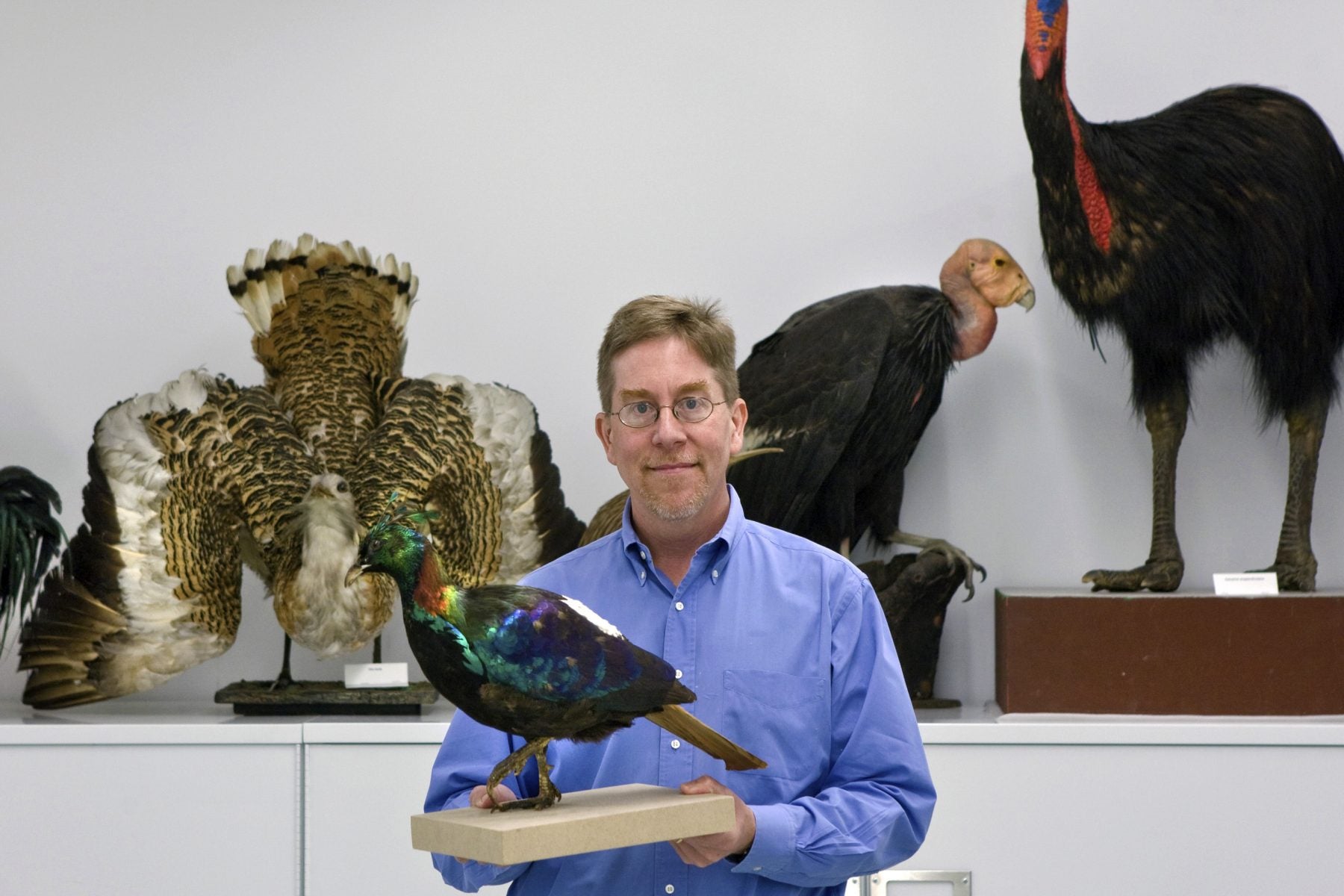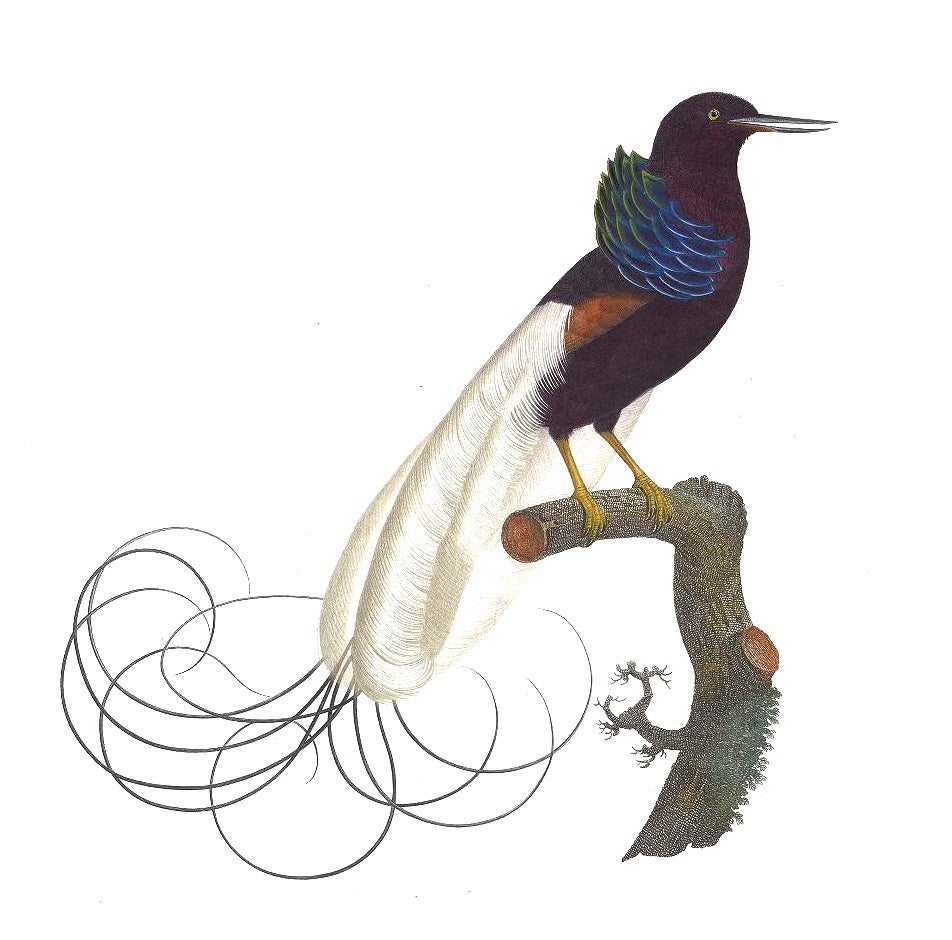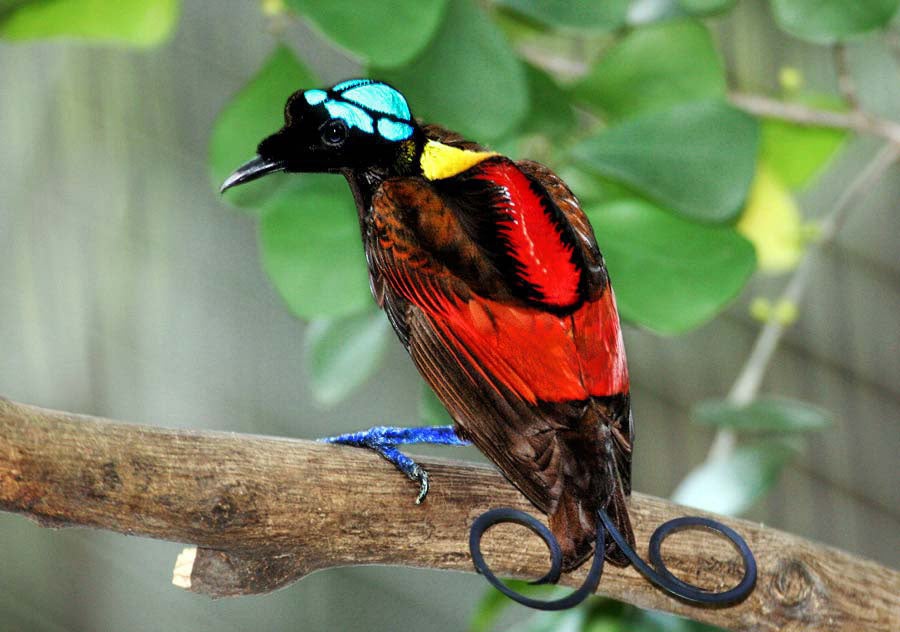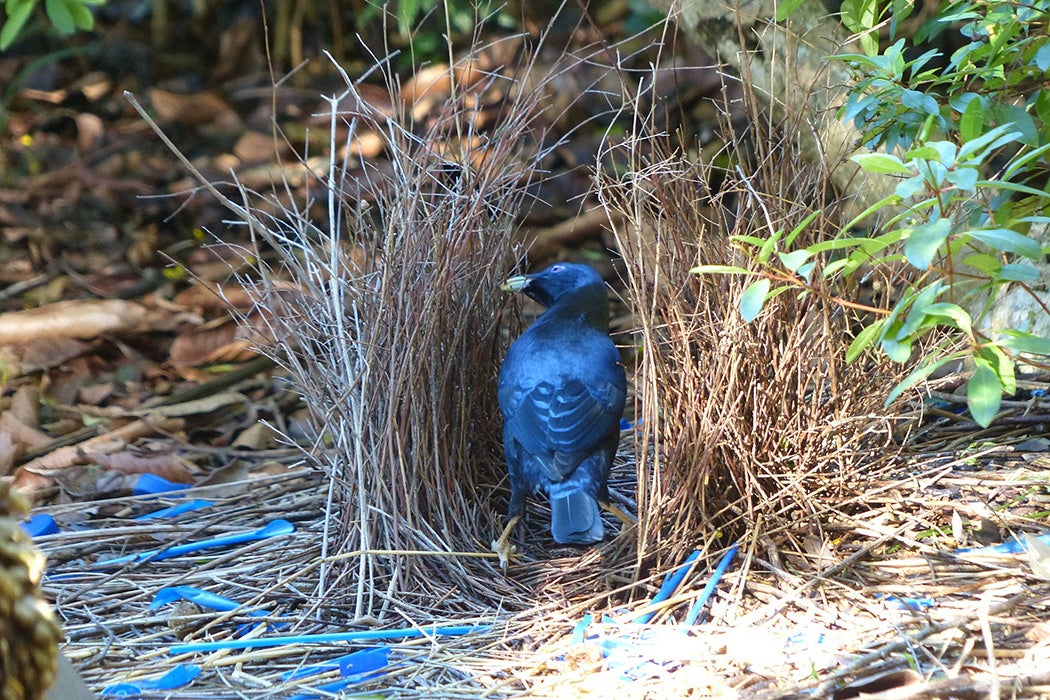
Like the dance of many birds, the mating display of the large southeast Asian pheasant, the Great Argus, is a sight to behold. With his long wing feathers spread out like a fan or arranged like flower petals around his tucked blue head, colors and shapes bedazzle the object of his affection. Yale University ornithologist and evolutionary biologist Richard O. Prum says the arrangement is “the most highly elaborated of any creature on earth,” and he knows of “nothing else… in nature [that] can rival the fantastic intricacy of this design.” Like millions of other birdwatchers in the United States, Prum is mesmerized by beauty.
But what purpose does that beauty serve? According to Prum, that beauty is more or less there for the pleasure of the female bird. Rather than relating some message to the beholder about physical fitness and “good genes,” these markings exist to please. What female birds find pleasing, they choose. Prum argues that there’s an evolutionary history of clues that shows us that these birds like beautiful things. It is their subjective sense that guides their mate choices.
Prum, a recipient of the MacArthur genius grant as well as a Guggenheim Fellowship, has been thinking about how aesthetic traits tie into evolution for many years. He’s been fascinated by birds in general for far longer, since he was a boy with binoculars staring up at the trees. He published his ideas under the title The Evolution of Beauty in 2017. Prum points out that we’ve mostly forgotten that the idea of “arbitrary beauty” has roots in one of Charles Darwin’s final works, The Descent of Man, and Selection in Relation to Sex. He spoke to me from New Haven, Connecticut about the meaning of arbitrary traits, the argument against them, and why he could never choose a favorite species of bird.
* * *
In trying to understand the ideas you explore in your 2017 book, The Evolution of Beauty, how should we conceive of that subjective sense of beauty as it relates to the female bird’s perspective? Is it separate from what humans think of when they think of such a loaded word as beauty?
What is amping up or giving the language a little extra charge is the “subjective.” It’s subjective experience. These animal preferences are really about that, and this concept has a lot of history, particularly going back to Darwin who was explicitly talking about the subjective experience of animals.
Trying to understand the consequences of the sensory worlds of animals has actually been a challenge for science for over a century. The early ethologists or animal behaviorists came up with the concept of the Umwelt, the surrounding sensory world, the sensory experience of the animal. They were thinking just in terms of foraging and orienting, avoiding predation, standard stuff, but they soon realized that, wow, this is also about the social interactions of these animals. Ethology hasn’t really been an active area of research as much recently, but I’m really returning to that notion.

Is it hard? Absolutely. Can we understand it entirely? No, and that’s at the heart of the “subjective” in general. My experience of the color green and your experience of the color green may correspond. Except for the fact that we can kind of understand our parallel descriptions, we don’t really have any confirmation of that. So, this problem of understanding subjective experience is not limited to animals. It’s part of the challenge in general, like with us.
I think we can make progress. Science gives us lots of good tools. One of the things that’s very special is that, even if we can’t understand what’s going on in the head of a bird, we can understand how social or sexual preferences change or evolve. And that’s allowing us in some way to make a kind of foxy maneuver to approach what’s going on in the head of the bird. We don’t know what it’s like for them to have experiences, but we can watch it change through its impact on co-evolved ornament. That’s a real science opportunity, and it’s one that I’m hoping that the book will emphasize as a future area of research.
But there is evidence based on research that animals have the sensory and cognitive capabilities to carry out mate choice?
People were skeptical back in the Victorian era whether animals were cognitively complicated enough to actually make coherent mate choices. What’s interesting is now, that aspect of Darwin’s proposal is completely mainstream, none challenging it today.
There are 150 years of studies, and many experimental. You could give a moth a chance to listen to two ultrasonic songs, one species specific and one not, or one disrupted in this way or one concocted in another way. Choice experiments, right? They’re not mating with the speaker, but they are giving us an indication about positive behavioral association that’s associated with that.
Our appreciation of the complexity of the bird brain is such that now the bird brain is a major model for cognition in mammals—especially learning—because birds do think through songwriting, like really elaborate and repeatable learning, and that has now been a new way to understand ourselves. They have a different anatomy. They evolved independently from us. But that actually, maybe, is partly a feature of how brains work to make cognitive complexity.
What of course becomes a source of debate in science is: to what end? What is the force that’s leading to the evolution of traits and preferences? Is it really a kind of adaptation, or, as I propose, a more arbitrary process that can be based entirely on subjective preferences?
As you wrote in the book, Darwin said that “birds appear to have the most aesthetic of all animals.” In thinking about the ornaments of birds, how unique are they to display such features?
What makes birds so relatable to Darwin, and to us, and to me as a child, is that they communicate with each other prominently in color and in sound, and of course these are both sensory modalities that human beings appreciate and exploit for their own communication. And so, that means we understand them and relate to them really well, but there are a lot of organisms that have entirely different kinds of sensory worlds.
Although they’re not about ornament, you can think about the sonar constructed world of the bats, or the olfactory world of a mole, which are incredibly rich and yet completely alien to us—or almost entirely alien—in their richness. And then there are organisms, like a mormyrid fish, a number of different families of fish, that sense their world in murky rivers in the tropics with electrical fields. They also have happened to evolve to sing songs that are social and sexual, and they are electrical songs that vary in tempo and in frequency—just like music but in an entirely different or distinctive wave.
These are examples of aesthetic experiences and productions that we are completely insensible to. In some ways, we might be able to analyze them, but we could never subjectively experience them.
Do birds within species have a collective sense of beauty?
It’s fascinating. I think the answer is variable. It’s true that a lot of the birds that I’m talking about in the book are aesthetically extreme. That is, they have really amazing and elaborate ornaments. Those kinds of ornaments tend to be associated with very strong, normative evaluation by members of the species. That is, there is an idea or some evolved set of preferences, and they can be extremely strict, but that implies low variance.
But there are lots of different kinds of birds and lots of different kinds of ornaments. So, in the book, I didn’t talk much about song, but a lot of birds learn their songs. About half the species of birds in the world learn their songs from other members of their species. The songs are sung often as sexual ornaments, and mate choice takes place on the base of the song. The preferences themselves are also learned, so, in this case, you have true culture going on in the birds, and it’s been elaborated for tens of millions of years. In that case, you get lots and lots of interesting variants.
You get dialects that occur basically for the same reason as human dialects. Often birds in Boston, New York, and Chicago will sound differently, just like the people do, and for basically the same exact reasons. Those reasons don’t have to do with the wind in Chicago or the salt air in New York, but with the contingency and history of regionalism and random changes happening that influence this sort of cultural evolution process.
One of the cool things about avian aesthetics is that it’s incredibly rich and gives us examples of really strict ideas, about what beauty can be, and very open-ended and influenceable, even socially contrived ways of recognizing and preferring ornaments.
Clearly, humans have a very diverse conception of beauty, depending on culture and society, among many other factors. Is there any evolutionarily derived, collective ideal that we have of beauty?
Talking about human aesthetics requires distinguishing evolved and even cultural, sexual aesthetics, which is the topic of the book in animals, from all the other ways in which we have aesthetic experience—you know, art and literature. We do aesthetics in a big way, not just in the context of sexual communication.
Talking about human sexual aesthetics is difficult or challenging because people are so complicated, and the reason why is that every mechanism of evolution is going on and has gone on persistently in human evolution. You’ve got male-male competition and female-female competition, male choice and female choice. You have sexual coercion and sexual conflict that consist of male coercion and female coercion. And, on top of that, you have culture. All of those things are influencing both the experiences that people have and their outcomes, and they give rise to diversity.

What we really need is to embrace an explicitly aesthetic research program in humans and then begin to characterize elements of that aesthetic, the aesthetic properties that are broadly distributed. I would push back from the claim that there are universal aesthetic values to human sexuality, not because I don’t think that we have evolved and that there aren’t evolutionary inputs to it, but because there are so many other things going on that identifying what they are, and in a way that isn’t biased by the kind of research programs we do, is really hard. So, I don’t think we’re there yet, and it’s kind of exciting to me to think that the field of beauty studies and evolutionary beauty studies has a lot of more stuff to do.
Now, there are plenty of people in evolutionary psychology and even in areas of anthropology that might make claims about universal aesthetic values in human sexuality, but I think they’re, for the most part, pretty poorly supported right now. Mostly that’s because the research programs have been aimed at confirming adaptive hypotheses about the function of such ornaments that I resist.
What is the hypothesis “Beauty Happens,” and why is it important?
The authentically Darwinian view is that sexual ornaments are arbitrary—that is that they co-evolve with a preference but without material or informational improvement or opportunities for improvement.
The contrasting idea comes from Alfred Russel Wallace. The Wallacian idea is that all ornament is correlated with other adaptive advantage, whether it’s direct benefits like defense from predators or more worms or better calories or no sexually transmitted diseases, or genetic benefits, indirect benefits, like better genes in general for my offspring. These are the two alternatives.
My first challenge is to get people to take the arbitrary seriously, but, when we do, how do we distinguish between the two? Well, I propose that the Darwinian aesthetic perspective, the fully aesthetic perspective, the arbitrary perspective, is the null model. What I mean by that is that should be our go-to explanation or expectation of the world in absence of other adaptive explanation.
For Wallacians, most ornaments are like a rainbow leading to a pot of gold, and so the peacock’s tail is like a rainbow leading to an extrinsic benefit, a benefit that is not the beauty but something else. And what’s in the pot of gold? The pot of gold includes good genes and protection from sexually transmitted diseases or predators. It’s advantage; it’s wealth. The advantage is in the gold. This is the idea that the value of the beauty is extrinsic to the beauty.
But to the Darwinian view, the value of beauty is just the rainbow. Beauty is just… It’s essentially the consequence of its sensory perception. That means that the value of beauty is intrinsic. So, where does value come from? Well, it’s socially contrived, either genetically, as in Lande-Kirkpatrick, or in a cultural sense.
If you ask which is the null model, the next time you see a rainbow, imagine a leprechaun coming up to you and asking you, “Is there a pot of gold at the end of the rainbow?” Ask yourself, what’s the null model? The null model, of course, is that there’s no gold. Why? Because the association between this extraordinary sensory experience and some other thing is the exceptional property of an adaptive hypothesis.
The Wallacians are evolutionary leprechauns. They would require that we believe that, as a matter of faith, there’s always a pot of gold at the end of the rainbow. I’m really saying the obvious, which is that the burden of proof is not a leprechaun and that science should be structured in a way that allows for the Darwinian perspectives to be the result of the scientific research program, as opposed to excluded by a faith-based research program, which is what most of the literature is.
People look for direct and indirect benefits and if they don’t find them, they assume that they haven’t worked hard enough to find them. That is the operational way in the discipline. Beauty Happens is really the proposal that we need an intellectually effective null model and that that null model should be the arbitrary one.
You mentioned the Lande-Kirkpatrick finding. How do their models show the true meaning of arbitrary?
One of the properties of this is that sexual signals are arbitrary, and that doesn’t mean that they’re historically random. It doesn’t mean that they’re accidental. What it means is that they do not encode any information about mate quality that is advantageous or actionable. That is, a long tail or a purple tail or this song or that song can be merely beautiful. This hypothesis was an absolutely fundamental feature of Darwin’s theory. It was criticized vigorously by Alfred Russel Wallace and others at the time. One of the responses to it was basically to take sexual selection and say it’s just another kind of natural selection, and what that was effectively doing was squashing this possibility.
One of the more modern contributions to this whole literature has been the Lande-Kirkpatrick population genetic model. Lande and Kirkpatrick put together a series of models in the 1980s which showed essentially how preference for arbitrary traits can be contrived, socially contrived, in a population. This is analogous to an irrationally exuberant market bubble for a hot stock or the latest IPO. People buy it because other people are buying it, and other people are buying it because they think other people will buy it whether or not there’s any value in the product of that company at all or in the value of that commodity. There’s lots of reasons to imagine this process can occur, and now we have a good understanding of the genetics of how it might occur.
Why is an elaborate display trait more costly according to the Amotz Zahavi’s handicap principle?
The idea of Zahavi is that the cost of display, whether it’s the investment cost of making it or the cost of surviving it, just like being around, shaking your tail, and possibly attracting predators. There’s direct cost and indirect cost. The point of those costs is to show how good you are. This is basically what he called the handicap principle, the idea that handicaps allow for an ornament to be honest and that the honesty is encoded in the costliness.

In the book and in previous work, I’ve criticized this idea, and so I’ve received a fair amount of criticism as well. Although it’s really a way to ensure or to imagine the Wallacian world is always true, it’s an explanation that turns out to be remarkably weak. One of the reasons is that if somebody’s fiancé gives them a diamond engagement ring that’s worth four years of salary, and if as a result they have to live in a cardboard box, then they are made materially worse by doing so.
So, you have to ask, okay, at what point is it worthwhile? Well, the only way that it can be worthwhile is if quality in nature in animals is distributed like money in humans, so that some people have extra that they can waste and some people don’t have enough even to make, if you will, the monthly bills—whatever the analogy would be in birds. That is an open question.
Although Zahavi’s papers are cited thousands of times, I didn’t find a single paper that actually tried to test that in a wild population. People use the concept of Zahavi as a way to make themselves feel better about the intellectual importance of honesty and of adapted benefits in mate choice, but they still haven’t gone back to test the idea, and that’s a problem for the science.
What part does female preference, choice, play in the evolution of biological diversity? Especially when sexual coercion via sexual violence and social control can also be factors.
One of the things that was fascinating in this research program was to have the aesthetic perspective on sexual selection be so productive in an entirely unexpected way, and that unexpected way was analysis of the really problematic topic of sexual conflict. What happens when freedom of choice is infringed upon by sexual violence and coercion?
In my own research, it started with work on duck sex but has expanded into other species. In regard to the duck sex, we could be here for another hour.
But basically the bottom line was that, from the adaptive view, people are trying to explain the outcome of sexual selection as an adaptation, that is, as a way of being better. If the female likes certain preferences, does she like them because the mates and the consequent offspring were better, better in some objective way in addition to being attractive, or merely attractive? Were they better in some material or objective way?
Now, the same was true of male-male competition. If there’s some battle that leads to some mating outcome, the guy with the big antlers, then the reason why it works is because that guy is better. He’s better materially in some way that led him to lead the competition. Right? So, this means that, as Wallace proposed, all outcomes are adaptive. But sexual conflict is this area where, when you have females, it’s going in one direction, and [with] male-male competition and conflict, [it’s] going in the other direction. It’s like, they can’t all be adaptive. So, right [away we understood] that this is an area where we would find some rich interaction.
What we discovered is that because we had thought seriously about the subjective experiencing of animals as a complete causal explanation of the evolution of ornament, or a plausible causal explanation of the evolution of ornament, that meant that we were prepared, for the first time, to see what can happen when choice is infringed by coercion. That is, we were set up to understand that the agency, the aesthetic agency of individuals was what was at stake. The bottom line of that research is that we discovered that freedom of choice matters to animals, that this is not just an idea. Sexual autonomy is not just an idea invented by suffragettes and feminists in the 19th and 20th century, but an evolved feature of the social-sexual lives of other animals.
That was the kind of discovery and a-ha moment that made me realize in a new way how intellectually productive the aesthetic view, Darwin’s aesthetic view, would be in evolutionary biology, because there has been a lot of work on this and none of it clarified these particular issues in ways that ours have. In subsequent work we’ve been doing, theoretical populations, modeling the process to show that, indeed, sexual autonomy can evolve, and that’s a really fascinating downstream product of the aesthetic view.
What examples do the Wallace proponents rely on to connect certain evolved traits or ornaments to something biological?
One of the classics that’s been proposed for a number of decades now is carotenoid plumages in birds. The carotenoids are molecules made by plants that have red, yellow, orange, and pink colors. Many species of birds use them to color their feathers, to make plumages brilliant, like cardinals or orioles or flamingos.
Because these molecules cannot be sensified by the individual—they’re found from the diet—it became popular, and has been since the early 1990s, to propose that these plumages indicate the quality of the diet of the individual. So, you get the molecules from the diet; you put them in your feathers. Redder is better because it shows that your diet is better. Now, this is interesting because, in fact, these molecules are useful. They’re important for vision. They’re antioxidants. So, having a lot of them may be useful in producing plumages.
There have been a large number of research studies to try to support this idea, but one of the crucial, fundamental assumptions of this idea is that carotenoids are somehow rare in the diet, that they are limited, that it’s possible to survive and not have an excess amount of carotenoids to put in your feathers. It turns out that the more you scrutinize it, the less supported this idea is, because we have every reason to think that carotenoids, which are fat-soluble, should bioaccumulate in the ecosystem, like DDT, but in a good way. That means that, at each step in the food chain, from plant to bird, their concentration should be increasing by a real magnitude. So, the larger the food chain, the more carotenoids will be available because all the animals in the food chain need them. They’re concentrating and digesting the fat of the organism that they ate and thereby decreasing concentration.
It turns out, when you study it, there’s no evidence that carotenoids are rare in the diets of any wild birds, period. Here’s this textbook example that turned out to be poorly supported. Now, there are a bunch of industrious people who are working to come up with new hypotheses for why carotenoids are still honest, but I think we ought to go to the intermediate stage of just recognizing as a science that that old hypothesis is falsified. They tend to be resistant to admitting that—but that’s part of the science process.
With regard to this mainstream evolutionary view, would you say that within the sciences in general, it is difficult to break off and conceive of and develop an idea that runs counter to the mainstream?
Many scientists would like to imagine that science is a kind of project that’s independent of the culture and stands aside or apart from politics and from other kinds of human motivation, but the message really is, surprise! Science is done by people! And we can’t escape that. That means that all the other concepts of kinds of conflicts and inefficiencies and difficulties that are part of all sorts of human endeavors are definitely part of science.

How do we respond to that? Well, we don’t throw our hands up and just give up on it. I think that means we have to use our scientific intelligences to try and understand ourselves and our cultural, social, political influences better and do better science. And that means changing. There are a lot of forces that make that change hard, and, obviously, I’ve seen it happen in my own life. When I was a student, the idea of creating phylogeny was kind of radical, literally radical and new, and now it’s totally mainstream, in the sense that students don’t even understand the way in which the idea was actually kind of suppressed for so long.
When I first started in ornithology, the idea that birds were dinosaurs was radical, and, in many corners, considered laughable. Now, children grow up knowing this as fact. And so, the world can change. That gives me faith and confidence, and I mean faith in the sense that you’re still working at improving science—you’re just not sure anybody’s going to read your papers! You have to have some faith that it’s going to get better.
What is the danger within the world of science in eliminating subjective ideas of sexual desire and pleasure within a rigidly objective framework?
Interestingly, the Victorians, in their era, iwere notably anxious about talking about sex, in particular about desire and the pleasure of sex. So that led to this anxious remove, if you will, a distance between the author and the topic, which you can sense in all these writers.
Then, as the twentieth century went on and people started studying animal behavior and psychology better, that anxious remove from the topic of pleasure and desire became built into the structure of science as the objective stance of science, and that leaves us, I think, still with a kind of objective science that is unable to actually study the scientific question that has to be at the center. How does pleasure and desire evolve?
So, that’s a problem, especially in the presence of an adaptationist perspective, leading to all sorts of adaptive theories for how that can happen, which leads to, I think, lots of consequences for understanding and thinking about human sexuality, human difference, and cultural and individual and personal variation in our culture today. I think there’s been a lot of negative impacts from that adaptive view projected irresponsibly onto people.
So, you’ve been a lifelong birder. Having now stocked so many “lifers” in your mental Rolodex of birds, what are some of your favorites?
Well, you know, interestingly, it’s incredibly hard. I mean, I would compare it to, say, which are your favorite children. You know? That’s grandiose, but no parent would even conjecture on that, right? It’s somehow a violation. I don’t know. There are just many, many of them.
Of course, the experiences of seeing them are not all equal, but there are multiple on all the continents. I remain fascinated by manakins and cotingas, two South American families I’ve worked on a lot. I spent a lot of time working on velvet asity in Madagascar. But recently, I’m starting to look at penguin pigments, and suddenly animals you sort of took for granted have new richness.
So, I back off from making a final claim to a favorite or even a small group of them, but I think that I know them when I see them, that they become prominent in the immediate sense.










